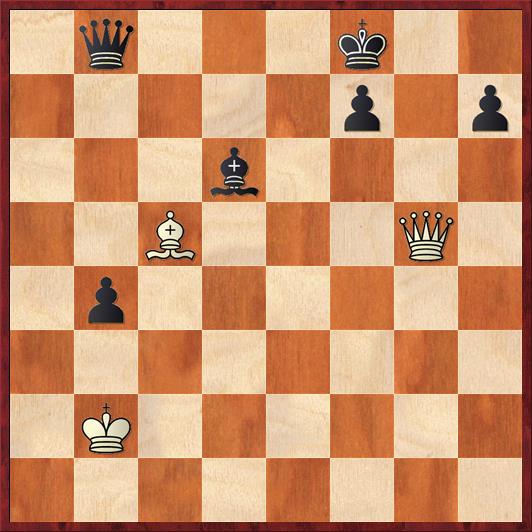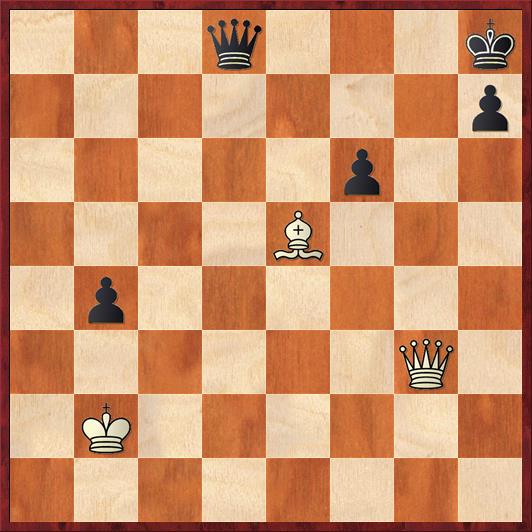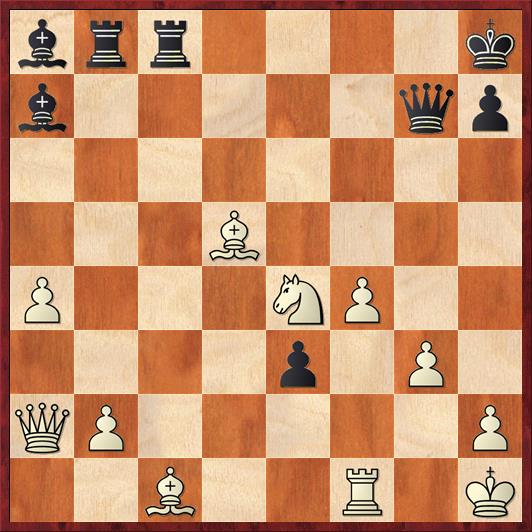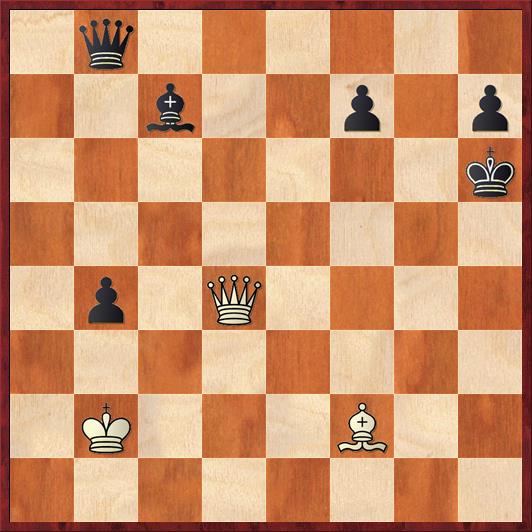Six years ago I wrote a post called Master Class, about a class taught by Varuzhan Akobian at the Berkeley Chess School, which I went to along with several of my chess friends. In the comment thread after my post there was a lively debate over whether the class was really worth the time and money. Suffice to say that several of us were at least a little bit disappointed.
But.
No time when you are truly engaged with chess is ever truly wasted! In Akobian’s class we spent probably an hour or two on some endgame studies, which he said were an important part of the Soviet chess school. I’ve never been a great fan of studies, because they are carefully composed and employ themes that seem too unlikely to arise in a real game. But Akobian showed one study, composer unknown, that made a lasting impression on me.
FEN: 1q6/2b2p1p/7k/8/1p1Q4/8/1K3B2/8 w – – 0 1
The solution begins in obvious enough fashion with 1. Qf6+ Kh5 2. Qf5+ Kh6. Obviously White could settle for a draw here with 3. Qf6+, and in a tournament situation many of us would probably do so (after all, we’re three pawns down!). But White continues to play checks, which seem almost aimless at first. 3. Be3+ Kg7 4. Qg5+ Kf8.
One thing that makes this such a great teaching example is the fact that Black only has one option at each move. 4. … Kh8?? would get mated after 5. Bd4+.
Now after 5. Bc5+ Bd6 we get the distinctive position of the study.
 Position after 5. … Bd6. White to play and win.
Position after 5. … Bd6. White to play and win.
FEN: 1q3k2/5p1p/3b4/2B3Q1/1p6/8/1K6/8 w – – 0 6
Here White plays the amazing move 6. Qe5!! This sets up the motif known as a cross-pin. It is a rare situation where the same piece is pinned in two different ways, and the pins create a cross on the chess board: the bishop on d6 is simultaneously pinned on the c5-f8 diagonal and on the e5-b8 diagonal.
One thing that makes cross-pins so amazing is that if you only had one pin, you probably wouldn’t even call it a pin. Take away the bishop on c5 and king on f8, and Black could just play 6. … Bxe5. Take away the queens on e5 and b8, and Black could just play 6. … Bxc5. But somehow the combination of two non-pins turns into an ultra-pin. In a ChessLecture that I gave on this topic, I compared a cross-pin to epoxy glue, in which you mix two chemicals, neither of which is effective alone, but together they form an unbreakable bond.
By the way, the study doesn’t end here! White is winning a piece, but with Q+B against Q+3P, is he really winning the game? Let’s see! Black has to play 6. … Kg8, stepping out of one of the pins. White plays 7. Bxd6, and Black’s move is again forced: 7. … Qd8, to stop Qg5+. White plays 8. Qg3+ Kh8 9. Be5+ f6, and once again it looks as if White is stymied.
 Position after 9. … f6. White to play and win.
Position after 9. … f6. White to play and win.
FEN: 3q3k/7p/5p2/4B3/1p6/6Q1/1K6/8 w – – 0 10
How does White make progress? The answer, once again, is a cross-pin! White plays 10. Qg5!! (Note, by the way, that 10. Qh4? would not do because Black plays 10. … Qd2+. That’s a beautiful little grace note added by the composer.) Incredible! Once again, neither pin would be effective alone, as Black’s f6 pawn could just take on e5 or g5, but together they are deadly. Black can do nothing to stop 11. Bxf6+ with either mate or the winning of a queen, so the study ends here.
Well, this is an amazing composition; after solving this problem you will never forget the idea of cross-pins. But can they ever happen in a real game?
Well, I have played hundreds of tournament games and thousands of games just for fun, and I can’t remember a single time when my opponent or I played a cross-pin. But who knows what opportunities might have been missed? After all, I never even heard of cross-pins until 2011.
Yesterday, though, there was a beautiful example of a cross-pin at the highest level of tournament chess. 2017 Reykjavik Open. Round 8. The top-seeded player, super-GM Anish Giri, playing Black against GM Alexander Donchenko. Giri was half a point behind the leaders, so he badly needed a win to catch up.
Giri became the butt of a lot of jokes last year when he played 14 consecutive draws in the Candidates Tournament in Moscow. But in this game he sure showed that he knew how to play for a win! The Dutch whiz kid played an ambitious two-pawn sacrifice that was probably not quite sound, but he succeeded in tying his German opponent up in knots. They got to this position a couple moves after the time control.
 Position after 43. Nxe4. Black to move.
Position after 43. Nxe4. Black to move.
FEN: brr4k/b5qp/8/3B4/P3NP2/4p1P1/QP5P/2B2R1K b – – 0 43
I got this position in an e-mail from my friend and former teammate Larry Smith, who included a clue that Black played a move here that forced an immediate resignation.
If I were playing Black, I would almost certainly play 43. … e2. I think that Black is winning after 44. Re1 Qd5! when White can’t take the e-pawn because of mate on g1. But still, after 45. Bxa8, the game is not even close to over. Certainly this is not a variation that would cause White to resign immediately.
It took me a minute, but I started trying to think of ways in which White’s bishop could be deflected from the long diagonal, and that’s when the solution hit me:
43. … Qf7!! 44. White resigns
Of course, if 44. Bxa8 Qxa2 wins the queen, and if 44. Bxf7 Bxe5+ 45. Kg1 e2+ 46. Rf2 e1R mate. Or e1Q mate. Or Rxc1 mate. Also, defending the bishop won’t help: 44. Nc3 Rxc3! or 44. Rd1 e2!
So this is why you pay attention in master class. Because some day, you’re going to be on board one in the Reykjavik Open and you’re going to need to know what a cross-pin is. Alas, I don’t think that I would have found this over the board; I only found it because of Larry’s clue that White resigned immediately. Kudos to Anish Giri, who I think saw the idea at least two or three moves earlier and baited his opponent into the trap.




{ 1 comment… read it below or add one }
Actually, the composer of that study is not at all unknown — it is Aleksey Troitsky, one of the masters of the early 20th century, and the study was published in L’Echiquier in 1930.
And I don’t agree with you that it is pointless to use studies as training material — my belief is to the contrary, in fact. But you have to select the studies with some care; as time goes by, it becomes more difficult to find new ideas, and this leads to modern studies being more complex, and more or less incomprehensible for chess players. So to get proper training, you need to go to the classics — Troitsky, the brothers Platov, Rinck, Kubbel, Reti, Prokes and their colleagues. I wrote a column for the Swedish magazine Schacknytt about 15 years ago where I tried to select studies suitable for training, and I am now putting them on my blog, one per week — if you can stand a little Swedish, you can check for yourself, http://blog.bosjo.net/category/schack/studier/. Short vocabulary: Vit -> white, svart -> black, vinner -> wins, remi -> draws, ledtråd -> hint, lösning -> solution. “Svårighetsgrad”, difficulty, is my estimate of how difficult it will be to solve it from the diagram; 1 is the easiest (may be solved by players about ELO 1700 having a good day) and 3 is the most difficult (about 2200). The error bars on these estimates are considerable, and everyone, at least below the level of grandmaster, should be proud of having solved one of them without “cheating”.
The idea is to emulate a tournament game, either by solving it from the diagram, or by setting up the position on a board, but not moving the pieces. If that doesn’t work, try solving it by moving the pieces around, or looking at the hints I have provided (unfortunately in Swedish as well, but Google translate may help?), and everything else fails, check the solution.